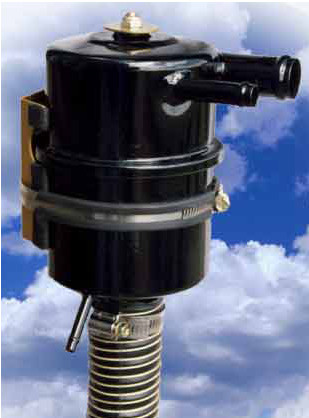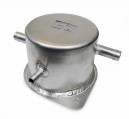Well that is easy to achieve by heating it, because OAT will always be below +100C – even under the cowling. I have already posted tests showing the crankcase reaches about +80C. So behind the engine will be much cooler.
How the hell do you keep the separator above +100C without electrically heating it?
Peter wrote:
So I think that old story about oil separators being bad because they feed back dirty oil is nonsense.
I agree. I don’t think there is any such thing. Engine oil, even after a couple of hours of use is pretty vile stuff, full of all sorts of crap, as any oil analysis will show. Maybe a comparison analysis between similar engines with and without separators would show the difference if there is any. Blackstones might be able to help.
I am looking into an air/oil separator as well. The main benefit I can see for me, is the ability to have more oil in the sump especially when climbing out on a hot day. I took off from Guernsey on Sunday (28C and max weight) and the oil temperature did not take long to get close to its maximum in the climb to 5000ft (at 19C).
The normal running level for the oil is 3 quarts below the maximum of 12. Fitting the separator gives me a significant increase in (usable) oil capacity and hopefully cooling and possibly lower consumption as it is not dumped onto the belly when filled above 9 quarts.
Reading about the Air Wolf separator

This above fact is what separates the Airwolf AirSep from all other air/oil separators. Airwolf is the only AirSep the actually dries your engine out by removing harmful moisture.
This contradicts what is all over the internet which is that all separators are the work of the devil.
The Aircraft Spruce kit is here at $595.
This site says a TB20 STC is available.
I can’t find any document showing the TB20 installation.
Another interesting bit is that they are using the vac pump output air which is said to be hot. That temperature is probably fairly constant since that air originates in the cockpit whose temperature is obviously not going to vary that much. It is drawn from the ambient, cockpit side of the firewall, via a filter.
A competitive product called an M-20 returns oil to one of the rocker covers, which is an “interesting” approach… but that product gets a lot of bad reviews.
I have one of these for homebuilders. It is rather bulky and was a kludge to fit in. The excess oil drains into the orange oil can, which I empty on annual inspections. There is always some oil in there, that much less to clean off the belly. The extra plumbing required to return this amount of oil to the crankcase seems like overkill. The iced tea can dumps cabin heat air out of the cowl flap when it is not needed in the cabin. 

Simon
The extra plumbing required to return this amount of oil to the crankcase seems like overkill.
I think there is a general belief that the separator returns litres of oil back and that oil lost from the breather is a major component of what gets used up by the engine.
This may be mistaken in which case the separator is probably not worth having.
What is your max level and what level do you normally run at?
I put in 7 litres at each oil change. Some is lost as I top up a bit before 50 hours is up. There is still some oil on the belly as I may not have the separator in the optimum position, but I recover 50 ml at most from my can, enough to oil my bicycle. If your engine is long in the tooth you might lose more from the breather, but I think there is some advertising hype. It was neither expensive nor difficult to fit on a homebuilt, but the labour and parts cost for a certified aircraft would probably outweigh any cleaning benefit.
Simon
Peter wrote:
Airwolf is the only AirSep the actually dries your engine out by removing harmful moisture.
I wouldn’t call that an oil separator. It’s more like a vapor drier. I wonder what happens to the temp when you splash oil into it though. My “separator” has a gravity operated ball valve, it’s designed to handle “mild” subzero G  It’s more of an oil collector than a separator.
It’s more of an oil collector than a separator.
… for 50 ml I would not install it. I thought it’s more effective than that.
I think the best solution is to know the oil consumption of your plane and to not put in too much. In both my SR22 and my PA-28 six quarts work the best. Sure, before crossing a 200 NM body of water I sometimes put in more, like 7, but never 8. Eight I only do at the oil and filter change, actually 8 plus Camguard. After two hours of flying it’s down to 6 …
Reply from Air Wolf:
No STC means a Field Approval, or treat it as a Minor Alteration. I wonder what others have done. I also wonder where the TB20 STC mentioned on the Skygeek website comes from? No IM probably means no STC.
While my answer from Air Wolf wasn’t very helpful/professional either, I think I found all relevant documentation. EASA mention the oil separator in their STC list:

That means the FAA STC SA02268CH directly applies (including future revisions of the documentation) and also the FAA STC AML (approved model list). Googling a bit finds this:
STC SA02268CH
STC SA02268CH AML
That means both FAA and EASA aircraft owners can just order it with an FAA 8130, install it and have it signed off by authorized personnel.